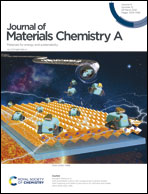Understanding cation-disordered rocksalt oxyfluoride cathodes†
Abstract
Partial fluorine (F) substitution into the oxygen (O) sublattice has been shown to improve cycling stability of cation-disordered Li-excess rocksalt oxide (DRX) cathodes. Detailed understanding on failure mechanisms and key optimization knowledge of fluorinated-DRX (F-DRX), however, are lacking. In the present study, we incorporate different amounts of F into a baseline DRX system, Li1.2Ti0.4Mn0.4O2 (LTMO3.0, 3.0 denotes nominal Li/Mn ratio), and synthesize two oxyfluoride compounds, Li-rich Li1.3Ti0.3Mn0.4O1.7F0.3 (LTMOF3.25) and Mn-rich Li1.2Ti0.2Mn0.6O1.8F0.2 (LTMOF2.0) with an increased and reduced Li/Mn ratio of 3.25 and 2.0, respectively. Through careful monitoring of chemical and structural evolution, we show that cycling-induced changes are manifested not only by Mn reduction and degradation of its local coordination environment, but also by F enrichment and formation of LiF-type of domains on the surface. A “concerted-densification” based failure mechanism, involving atomic-level changes in both transition-metal cationic sublattice and oxygen/fluorine anionic sublattice, is proposed for the degradation in F-DRX cathode materials. The study reveals that increasing F content accompanied by reduced Li/Mn ratio mitigates the degradation process, offering key design strategies in achieving balanced cathode capacity and stability.



 Please wait while we load your content...
Please wait while we load your content...